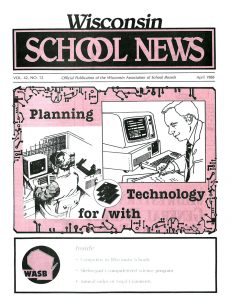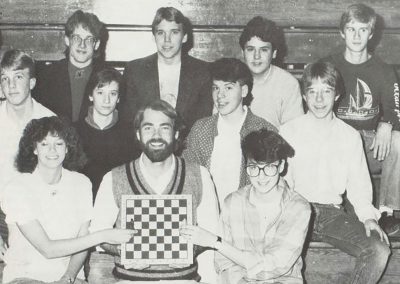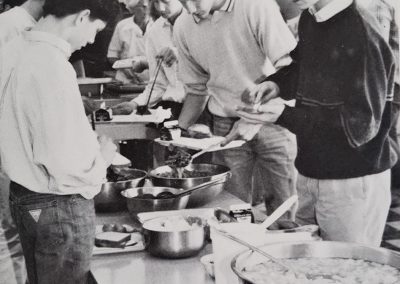 The 1980s
The 1980s
Ronald Reagan was elected president in 1980. In many ways, the decade belonged to him. Reagan oversaw a huge tax cut and then a rise in unemployment to 10% — the highest rate since the Great Depression — and a quadrupling of the national debt to $2.7 trillion. Reagan’s K-12 education reform focused on the 1983 “A Nation At Risk” report, contending, “If an unfriendly foreign power had attempted to impose on America the mediocre educational performance that exists today, we might well have viewed it as an act of war.”
The Cold War with the Soviet Union moved into a deep freeze as the United States dramatically increased defense spending while advancing policy initiatives to keep the Soviets off balance. In a 1987 West Berlin speech, Reagan challenged, “Mr. Gorbachev, tear down this wall.” Two years later, joyful Berliners from both sides did just that. Tiananmen Square, AIDS, glasnost and perestroika, Lt. Col. Oliver North and Iran-Contra, Jim and Tammy Faye Bakker, Chernobyl, Exxon Valdez, crack cocaine, the Strategic Defense Initiative, dubbed “Star Wars,” and big hair defined the decade.
The WASB

The April 1988 Wisconsin School News focused on technology that was emerging as tools and curriculum during the decade.
- 1980:The new WASB Insurance Plan offers member districts a variety of insurance coverages often difficult to attain in the open market.
- 1981: For the first time in the association’s 60-year history, all Wisconsin school districts and CESAs are WASB members.
- 1982: The Apple III computer installed in the WASB Winneconne office allows staff to send more timely legislative updates, memos and transcripts.
- 1983: The WASB FOCUS begins publication, providing an in-depth analysis of a specific policy topic and sample policies.
- 1985: Delegates recommend every school board establish a plan for board member continuing education.
- 1988: Executive director George Tipler, who was initially elected to the WASB Board of Directors in 1950, hands the reins to the association’s lead negotiator, Ken Cole. The new WASB Insurance Plan offers member districts a variety of insurance overages often difficult to attain in the open market.
WASB Presidents
1980 – Edward J. Coe – Rice Lake
1981 – Dr. J. Robert Curtis – Portage
1982 – Merlin Kilty – Colby
1983 – Leland Chenoweth – Blair
1984 – Barbara E. Meyer – Greendale
1985 – Reinhard Ulrich – Howards Grove
1986 – Henry Hendrickson – Viroqua
1987 – Harriet Jelinek – Rhinelander
1988 – John Schnurr – Wilmot
1989 – Jeanne Reed – Watertown
Our State
- 1980: Eric Heiden of Madison wins five speed skating Olympic gold medals in Lake Placid.
- 1981: Joseph H. Schlitz Brewing Co., “the beer that made Milwaukee famous,” taps its last keg.
- 1982: While signing the nation’s first law banning discrimination against gays and lesbians regarding housing and jobs, Republican Gov. Lee S. Dreyfus says, “There are some questions the government has no business asking.”
- 1984: An F5 tornado rips through Barneveld in southwestern Wisconsin, devastating the small community.
- 1985: Federal courts rule in favor of six Chippewa bands seeking off-reservation hunting, fishing and food-gathering rights based on provisions contained in 19th-century treaties ceding millions of acres to the federal government.
- 1987: Voters approve pari-mutuel betting and the lottery.
- 1988: The Chrysler auto plant in Kenosha — the nation’s oldest car factory — closes.
Our Nation
- 1980: Ted Turner launches CNN, the first 24-hour news channel; Mt. St. Helens erupts; and Pac-Man shows up
in arcades. - 1981: Reagan and Pope John Paul II survive assassination attempts; and “Video Killed the Radio Star” launches MTV.
- 1982: Visiting from outer space, “ET: The Extra-Terrestrial” captivates us while Dustin Hoffman entertains us in “Tootsie.”
- 1983: Sally Ride makes history as the first American woman astronaut in space; and the finale of M*A*S*H set a ratings record that would stand until 2010.
- 1984: A major party puts a woman, Rep. Geraldine Ferraro from New York, on the ticket for vice president for the first time.
- 1986: High school teacher Christa McAuliffe and her six fellow astronauts perish when the NASA space shuttle Challenger explodes shortly after lift-off.
- 1987: The publishing of Toni Morrison’s “Beloved” brings renewed attention to the horrors of slavery; and the U.S. Supreme Court rules Rotary Clubs must admit women.
- 1988: George H.W. Bush is elected president, becoming the first sitting vice president elected to the higher office since Martin Van Buren in 1836.


